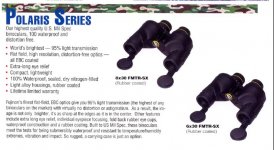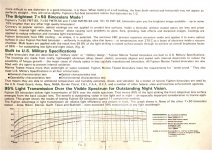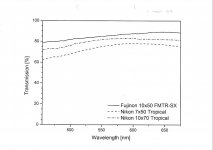I hope you don't mind I copied an old post of mine from Cloudy Nights about the Fujinon 10x50 FMT-SX compared to the Nikon 10x42 SE in low light. Henry might remember this thread on Cloudy Days on Cloudy Nights. I hope this helps some. I could post a link of the whole thread if someone wants it.This is just something I did and your results might be different. I saw a difference then, not sure if I would now 7 yrs. later.

To be fair I had tested both of these with just a 2 1/2 booster and got the same resolution and it could be that the Fuji might of tested better with more magnification. I think they were close enough to make this comparison ok, but what do I know.
Patrik might remember that thread, he replied a few times.
Posted 12 July 2007 - 08:32 PM
Hi Kenny "From what I hear , moore or less the whole of Europe eagerly awaits your further reports ."
You are so funny!!

Knowing that you Kenny J wanted a report on low light use of these two binoculars. I used my resolution test target in the evening about 7 different evenings. What I found is as the light level went down the Fujinon would still "see" two whole elements smaller than the Nikon 10 SE and still be able to "see" the largest element 2 and 1/2 min. later moore or less before it winked out about 9:35 PM . I had my "target" set up 25 steps away, I also found that I could still see group -1 element 5 or so when I walked up and viewed the target directly. I viewed deer in my fields in the evening comparing the Fuji and 10 SE. The Fuji had better contrast in these low light views of deer etc. and really wasn't surprised that the Fuji did better in the target low light "test".
I talked to my brother about this and he said that it really wasn't fair to compare a 10x50 against a 10x42 in this low light settings. What do you people think?
When the big dipper was pretty high in the sky, I searched out M81,M82 [also M51] and found I could see these targets better with the 10x50 Fuji , it wasn't a lot but it was there. I also had the little Leupold 6x30 Sam and I could see these two galaxies with the 6x30. I layed out a piece of plastic, put my sleeping bag on it and layed down. I rested my arms on two pillows to help hold the binoculars and enjoyed myself.
I guess this low light test is no surprise to a lot of you, but I thought it would be interesting to use test targets to see the difference for myself and with these two binoculars being optically so close it would be a good test. I wish I could of been able to have my coworker let me use my old Pentax PCF V 10x50 binocular to test to.
Regards,Steve M








